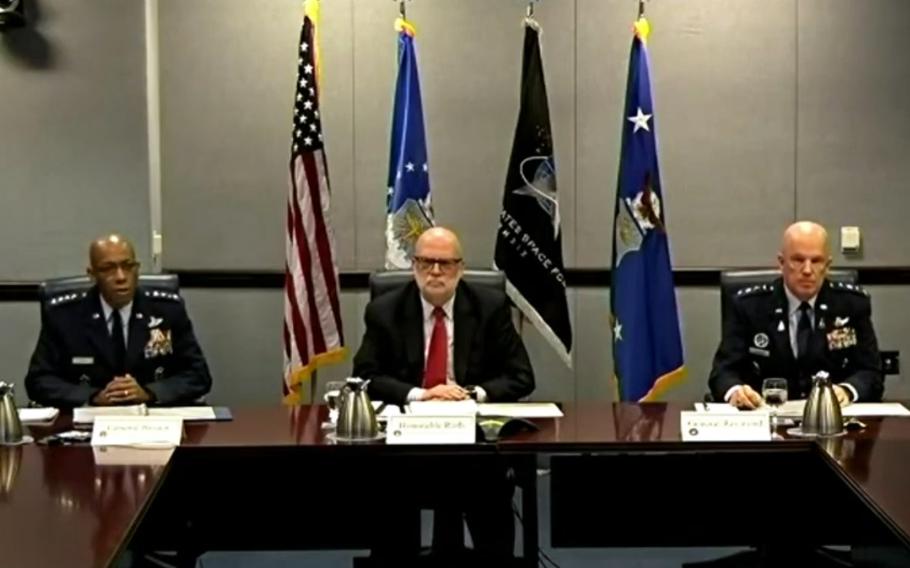
Air Force Chief of Staff Gen. Charles Q. Brown, left, delivers his opening statement at a House Appropriations Committee budget hearing, May 7, 2021. With him are Acting Air Force Secretary John P. Roth, center, and Space Force Chief of Operations Gen. John W. Raymond. (From a YouTube video)
Stars and Stripes is making stories on the coronavirus pandemic available free of charge. See more staff and wire stories here. Sign up for our daily coronavirus newsletter here. Please support our journalism with a subscription.
WASHINGTON — The Air Force’s chief of staff told House lawmakers on Friday that the service has slightly reduced its deficit in pilots, following initial concern that a reduction in flight training due to the coronavirus pandemic could exacerbate the Air Force’s long-standing pilot shortage.
“We've made some progress over the course of the past year, where we shortened the gap by about 200,” Gen. Charles “CQ” Brown said at an Air Force and Space Force budget hearing of the House Appropriations Committee’s subpanel on defense.
The coronavirus pandemic has led some pilots to look to the service for employment. Historically, some pilots have left the military to enjoy benefits that the commercial airline industry offers, such as more stable work hours, better pay and more flight time.
Early last year, the former Air Force chief of staff, Gen. David Goldfein, told lawmakers that the service remained about 2,000 pilots short of the 21,000 that the service believes are needed to meet requirements laid out in the 2018 National Defense Strategy. The strategy puts great-power competitors China and Russia at the forefront of national security concerns over issues such as global terrorism.
Rep. Henry Cuellar, D-Texas, pressed service officials on Friday about how the Air Force is addressing the issue that has plagued the service for several years, pointing out the 2,000-pilot deficit last year.
“We got to have something to address that issue of the pilot shortage. We have been talking about it for a long time, and we got to see some sort of change on that,” Cuellar said.
While the pandemic forced airlines temporarily to pause hiring as global travel slowed, Cuellar pointed out that it also hampered pilot training.
At the onset of the pandemic, Goldfein said the service had to cut back the size of its undergraduate pilot training courses and cut the amount of time pilot-trainees spend in the cockpit.
Brown said Friday that the service maintained the same rate of pilot production this year. The Air Force previously wrote in its fiscal year 2021 budget request that its goal is to grow by about 1,500 aviators per year by fiscal year 2024.
That is a “real testament to our airmen, and our operators and our maintainers to maintain the capacity and not slide back due to [the coronavirus]. It's a combination of production and retention and we're working both sides of that,” the general said.
Brown also said the service is working to increase introductory flight training and looking at ways to increase collaboration with civilian simulator instructors to free up more uniform members to increase production.
The service is also examining some commercial options, but Brown did not explain what those options are because they are still working out specifics.
Acting Air Force Secretary John Roth said the new Undergraduate Pilot Training 2.5 program, an initiative to modernize pilot instruction, aims to improve specialized skills. Ten Air Force pilots received their wings in March at Joint Base San Antonio-Randolph in Texas after graduating from the first leg of the program.
The program uses digital learning through virtual instruction and immersive training devices, in addition to hands-on learning, according to the Air Force.
“We’re also trying to take a look at leveraging things like simulators … are there some ways that we can leapfrog the system in terms of bringing in pilots from the civilian world, and not making them go through every step and perhaps getting them into a cockpit sooner,” Roth said.
Brown said the service also wants to strengthen relationships with universities that have aviation programs to accelerate the time that service members go through Air Force pilot training.
Cammarata.Sarah@stripes.com Twitter: @sarahjcamm